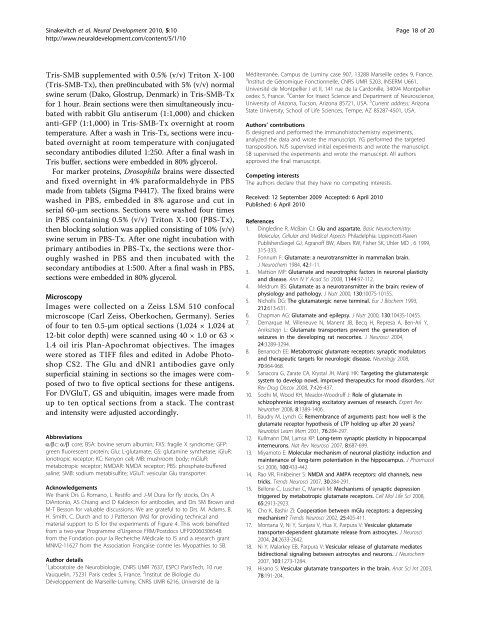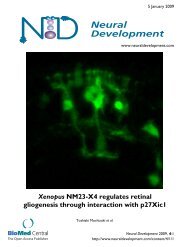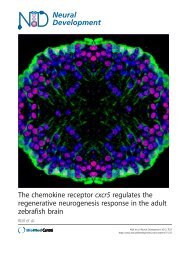Dynamics of glutamatergic signaling in the mushroom ... - HAL - ESPCI
Dynamics of glutamatergic signaling in the mushroom ... - HAL - ESPCI
Dynamics of glutamatergic signaling in the mushroom ... - HAL - ESPCI
Create successful ePaper yourself
Turn your PDF publications into a flip-book with our unique Google optimized e-Paper software.
S<strong>in</strong>akevitch et al. Neural Development 2010, 5:10<br />
http://www.neuraldevelopment.com/content/5/1/10<br />
Page 18 <strong>of</strong> 20<br />
Tris-SMB supplemented with 0.5% (v/v) Triton X-100<br />
(Tris-SMB-Tx), <strong>the</strong>n pre0<strong>in</strong>cubated with 5% (v/v) normal<br />
sw<strong>in</strong>e serum (Dako, Glostrup, Denmark) <strong>in</strong> Tris-SMB-Tx<br />
for 1 hour. Bra<strong>in</strong> sections were <strong>the</strong>n simultaneously <strong>in</strong>cubated<br />
with rabbit Glu antiserum (1:1,000) and chicken<br />
anti-GFP (1:1,000) <strong>in</strong> Tris-SMB-Tx overnight at room<br />
temperature. After a wash <strong>in</strong> Tris-Tx, sections were <strong>in</strong>cubated<br />
overnight at room temperature with conjugated<br />
secondary antibodies diluted 1:250. After a f<strong>in</strong>al wash <strong>in</strong><br />
Tris buffer, sections were embedded <strong>in</strong> 80% glycerol.<br />
For marker prote<strong>in</strong>s, Drosophila bra<strong>in</strong>s were dissected<br />
and fixed overnight <strong>in</strong> 4% paraformaldehyde <strong>in</strong> PBS<br />
made from tablets (Sigma P4417). The fixed bra<strong>in</strong>s were<br />
washed <strong>in</strong> PBS, embedded <strong>in</strong> 8% agarose and cut <strong>in</strong><br />
serial 60-μm sections. Sections were washed four times<br />
<strong>in</strong> PBS conta<strong>in</strong><strong>in</strong>g 0.5% (v/v) Triton X-100 (PBS-Tx),<br />
<strong>the</strong>n block<strong>in</strong>g solution was applied consist<strong>in</strong>g <strong>of</strong> 10% (v/v)<br />
sw<strong>in</strong>e serum <strong>in</strong> PBS-Tx. After one night <strong>in</strong>cubation with<br />
primaryantibodies<strong>in</strong>PBS-Tx,<strong>the</strong>sectionswerethoroughly<br />
washed <strong>in</strong> PBS and <strong>the</strong>n <strong>in</strong>cubated with <strong>the</strong><br />
secondary antibodies at 1:500. After a f<strong>in</strong>al wash <strong>in</strong> PBS,<br />
sections were embedded <strong>in</strong> 80% glycerol.<br />
Microscopy<br />
Images were collected on a Zeiss LSM 510 confocal<br />
microscope (Carl Zeiss, Oberkochen, Germany). Series<br />
<strong>of</strong> four to ten 0.5-μm optical sections (1,024 × 1,024 at<br />
12-bit color depth) were scanned us<strong>in</strong>g 40 × 1.0 or 63 ×<br />
1.4 oil iris Plan-Apochromat objectives. The images<br />
were stored as TIFF files and edited <strong>in</strong> Adobe Photoshop<br />
CS2. The Glu and dNR1 antibodies gave only<br />
superficial sta<strong>in</strong><strong>in</strong>g <strong>in</strong> sections so <strong>the</strong> images were composed<br />
<strong>of</strong> two to five optical sections for <strong>the</strong>se antigens.<br />
For DVGluT, GS and ubiquit<strong>in</strong>, images were made from<br />
up to ten optical sections from a stack. The contrast<br />
and <strong>in</strong>tensity were adjusted accord<strong>in</strong>gly.<br />
Abbreviations<br />
a/bc: a/b core; BSA: bov<strong>in</strong>e serum album<strong>in</strong>; FXS: fragile X syndrome; GFP:<br />
green fluorescent prote<strong>in</strong>; Glu: L-glutamate; GS: glutam<strong>in</strong>e syn<strong>the</strong>tase; iGluR:<br />
ionotropic receptor; KC: Kenyon cell; MB: <strong>mushroom</strong> body; mGluR:<br />
metabotropic receptor; NMDAR: NMDA receptor; PBS: phosphate-buffered<br />
sal<strong>in</strong>e; SMB: sodium metabisulfite; VGluT: vesicular Glu transporter.<br />
Acknowledgements<br />
We thank Drs G Romano, L Restifo and J-M Dura for fly stocks, Drs A<br />
DiAntonio, AS Chiang and D Kalderon for antibodies, and Drs SM Brown and<br />
M-T Besson for valuable discussions. We are grateful to to Drs. M. Adams, B.<br />
H. Smith, C. Durch and to J Patterson (Ms) for provid<strong>in</strong>g technical and<br />
material support to IS for <strong>the</strong> experiments <strong>of</strong> Figure 4. This work benefited<br />
from a two-year Programme d’Urgence FRM/Postdocs UFP20060306548<br />
from <strong>the</strong> Fondation pour la Recherche Médicale to IS and a research grant<br />
MNM2-11627 from <strong>the</strong> Association Française contre les Myopathies to SB.<br />
Author details<br />
1 Laboratoire de Neurobiologie, CNRS UMR 7637, <strong>ESPCI</strong> ParisTech, 10 rue<br />
Vauquel<strong>in</strong>, 75231 Paris cedex 5, France.<br />
2 Institut de Biologie du<br />
Développement de Marseille-Lum<strong>in</strong>y, CNRS UMR 6216, Université de la<br />
Méditerranée, Campus de Lum<strong>in</strong>y case 907, 13288 Marseille cedex 9, France.<br />
3 Institut de Génomique Fonctionnelle, CNRS UMR 5203, INSERM U661,<br />
Université de Montpellier I et II, 141 rue de la Cardonille, 34094 Montpellier<br />
cedex 5, France.<br />
4 Center for Insect Science and Department <strong>of</strong> Neuroscience,<br />
University <strong>of</strong> Arizona, Tucson, Arizona 85721, USA.<br />
5 Current address: Arizona<br />
State University, School <strong>of</strong> Life Sciences, Tempe, AZ 85287-4501, USA.<br />
Authors’ contributions<br />
IS designed and performed <strong>the</strong> immunohistochemistry experiments,<br />
analyzed <strong>the</strong> data and wrote <strong>the</strong> manuscript. YG performed <strong>the</strong> targeted<br />
transposition. NJS supervised <strong>in</strong>itial experiments and wrote <strong>the</strong> manuscript.<br />
SB supervised <strong>the</strong> experiments and wrote <strong>the</strong> manuscript. All authors<br />
approved <strong>the</strong> f<strong>in</strong>al manuscript.<br />
Compet<strong>in</strong>g <strong>in</strong>terests<br />
The authors declare that <strong>the</strong>y have no compet<strong>in</strong>g <strong>in</strong>terests.<br />
Received: 12 September 2009 Accepted: 6 April 2010<br />
Published: 6 April 2010<br />
References<br />
1. D<strong>in</strong>gled<strong>in</strong>e R, McBa<strong>in</strong> CJ: Glu and aspartate. Basic Neurochemistry:<br />
Molecular, Cellular and Medical Aspects Philadelphia: Lipp<strong>in</strong>cott-Raven<br />
PublishersSiegel GJ, Agran<strong>of</strong>f BW, Albers RW, Fisher SK, Uhler MD , 6 1999,<br />
315-333.<br />
2. Fonnum F: Glutamate: a neurotransmitter <strong>in</strong> mammalian bra<strong>in</strong>.<br />
J Neurochem 1984, 42:1-11.<br />
3. Mattson MP: Glutamate and neurotrophic factors <strong>in</strong> neuronal plasticity<br />
and disease. Ann N Y Acad Sci 2008, 1144:97-112.<br />
4. Meldrum BS: Glutamate as a neurotransmitter <strong>in</strong> <strong>the</strong> bra<strong>in</strong>: review <strong>of</strong><br />
physiology and pathology. J Nutr 2000, 130:1007S-1015S.<br />
5. Nicholls DG: The <strong>glutamatergic</strong> nerve term<strong>in</strong>al. Eur J Biochem 1993,<br />
212:613-631.<br />
6. Chapman AG: Glutamate and epilepsy. J Nutr 2000, 130:1043S-1045S.<br />
7. Demarque M, Villeneuve N, Manent JB, Becq H, Represa A, Ben-Ari Y,<br />
Aniksztejn L: Glutamate transporters prevent <strong>the</strong> generation <strong>of</strong><br />
seizures <strong>in</strong> <strong>the</strong> develop<strong>in</strong>g rat neocortex. J Neurosci 2004,<br />
24:3289-3294.<br />
8. Benarroch EE: Metabotropic glutamate receptors: synaptic modulators<br />
and <strong>the</strong>rapeutic targets for neurologic disease. Neurology 2008,<br />
70:964-968.<br />
9. Sanacora G, Zarate CA, Krystal JH, Manji HK: Target<strong>in</strong>g <strong>the</strong> <strong>glutamatergic</strong><br />
system to develop novel, improved <strong>the</strong>rapeutics for mood disorders. Nat<br />
Rev Drug Discov 2008, 7:426-437.<br />
10. Sodhi M, Wood KH, Meador-Woodruff J: Role <strong>of</strong> glutamate <strong>in</strong><br />
schizophrenia: <strong>in</strong>tegrat<strong>in</strong>g excitatory avenues <strong>of</strong> research. Expert Rev<br />
Neuro<strong>the</strong>r 2008, 8:1389-1406.<br />
11. Baudry M, Lynch G: Remembrance <strong>of</strong> arguments past: how well is <strong>the</strong><br />
glutamate receptor hypo<strong>the</strong>sis <strong>of</strong> LTP hold<strong>in</strong>g up after 20 years?<br />
Neurobiol Learn Mem 2001, 76:284-297.<br />
12. Kullmann DM, Lamsa KP: Long-term synaptic plasticity <strong>in</strong> hippocampal<br />
<strong>in</strong>terneurons. Nat Rev Neurosci 2007, 8:687-699.<br />
13. Miyamoto E: Molecular mechanism <strong>of</strong> neuronal plasticity: <strong>in</strong>duction and<br />
ma<strong>in</strong>tenance <strong>of</strong> long-term potentiation <strong>in</strong> <strong>the</strong> hippocampus. J Pharmacol<br />
Sci 2006, 100:433-442.<br />
14. Rao VR, F<strong>in</strong>kbe<strong>in</strong>er S: NMDA and AMPA receptors: old channels, new<br />
tricks. Trends Neurosci 2007, 30:284-291.<br />
15. Bellone C, Luscher C, Mameli M: Mechanisms <strong>of</strong> synaptic depression<br />
triggered by metabotropic glutamate receptors. Cell Mol Life Sci 2008,<br />
65:2913-2923.<br />
16. Cho K, Bashir ZI: Cooperation between mGlu receptors: a depress<strong>in</strong>g<br />
mechanism? Trends Neurosci 2002, 25:405-411.<br />
17. Montana V, Ni Y, Sunjara V, Hua X, Parpura V: Vesicular glutamate<br />
transporter-dependent glutamate release from astrocytes. J Neurosci<br />
2004, 24:2633-2642.<br />
18. Ni Y, Malarkey EB, Parpura V: Vesicular release <strong>of</strong> glutamate mediates<br />
bidirectional <strong>signal<strong>in</strong>g</strong> between astrocytes and neurons. J Neurochem<br />
2007, 103:1273-1284.<br />
19. Hisano S: Vesicular glutamate transporters <strong>in</strong> <strong>the</strong> bra<strong>in</strong>. Anat Sci Int 2003,<br />
78:191-204.




